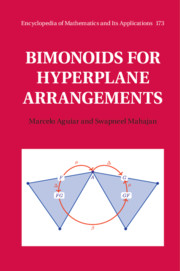Book contents
- Frontmatter
- Contents
- Preface
- Introduction
- Part I Species and operads
- Part II Basic theory of bimonoids
- Chapter 5 Primitive filtrations and decomposable filtrations
- Chapter 6 Universal constructions
- Chapter 7 Examples of bimonoids
- Chapter 8 Hadamard product
- Chapter 9 Exponential and logarithm
- Chapter 10 Characteristic operations
- Chapter 11 Modules over monoid algebras and bimonoids in species
- Chapter 12 Antipode
- Part III Structure theory for bimonoids
- Appendices
- References
- List of Notations
- List of Tables
- Author Index
- Subject Index
Chapter 12 - Antipode
from Part II - Basic theory of bimonoids
Published online by Cambridge University Press: 28 February 2020
- Frontmatter
- Contents
- Preface
- Introduction
- Part I Species and operads
- Part II Basic theory of bimonoids
- Chapter 5 Primitive filtrations and decomposable filtrations
- Chapter 6 Universal constructions
- Chapter 7 Examples of bimonoids
- Chapter 8 Hadamard product
- Chapter 9 Exponential and logarithm
- Chapter 10 Characteristic operations
- Chapter 11 Modules over monoid algebras and bimonoids in species
- Chapter 12 Antipode
- Part III Structure theory for bimonoids
- Appendices
- References
- List of Notations
- List of Tables
- Author Index
- Subject Index
Summary
For any q-bimonoid (relative to a fixed hyperplane arrangement), we define its antipode as a map from the bimonoid to itself whose face-components are defined by taking an alternating sum with each summand being the composite of a coproduct componentfollowed by a product component. We refer to this formula as the Takeuchi formula. Up to signs, it equals the 0-logarithm of the identity map on the bimonoid. There is also a commutative analogue of this formula for bicommutative bimonoids. We study interactions of the antipode with morphisms of bimonoids, the duality functor, bimonoid filtrations, the signature functor. The antipode is intimately related to the antipodal map on the arrangement; this is brought forth by its interaction with op and cop constructions. We compute logarithm of the antipode map using the noncommutative Zaslavsky formula, and moreover relate it to logarithm of the identity map. Understanding the cancelations in the Takeuchi formula for a given bimonoid is often a challenging combinatorial problem. We solve this problem for the exponential bimonoid, the bimonoid of chambers, the bimonoid of faces, the bimonoid of flats, and so on. More generally, we provide cancelation-free formulas for the antipode of any bimonoid which arises from a universal construction. In a similar vein, for any set-bimonoid, this problem can be interpreted as the calculation of the Euler characteristic of a cell complex. The descent and lune identities provide motivating examples of such a calculation. The antipode map is closely related to the Takeuchi elements associated to arrangements. More precisely, the face-component of the antipode map is the characteristic operation by the Takeuchi element of the arrangement over the support of that face. This connection makes it possible to study the antipode using properties of the Takeuchi elements.
Keywords
Information
- Type
- Chapter
- Information
- Bimonoids for Hyperplane Arrangements , pp. 495 - 528Publisher: Cambridge University PressPrint publication year: 2020
